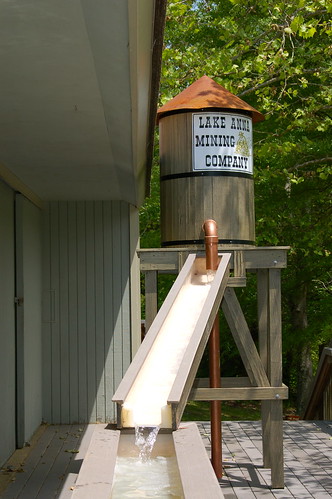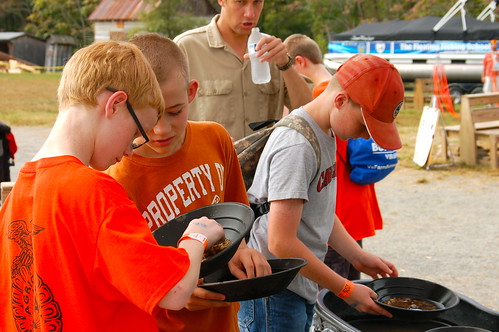Read Our Blogs
Gold mining could be coming back to Lake Anna State Park - Part 1
Posted May 17, 2013
Shared by Ann Henderson, as Guest Blogger.
Most people think of Lake Anna State Park as the park that is close to Dominion Powers’ North Anna Nuclear Power Plant. While this is true, the history of the park’s land takes us to a different source of power – gold!
Before becoming a state park, the property was known as Gold Hill and was part of the Goodwin Gold Mine. The land for the park was acquired in 1972 and work began on developing the park which opened in 1983.

Spot evidence of placer and shaft mining along Gold Hill trail
Here is a little history on gold mining in Virginia...
In the late 1700’s gold was found in Virginia and there is a large gold vein that runs along the base of the Appalachian Mountains from Maryland down to Georgia. Gold mining began somewhere around 1804 to 1806 (depending on the source) at the Whitehall mine in the western part of Spotsylvania County making Virginia one of the first gold producing states in the nation.
When we think of gold mining our minds automatically go to the prospectors in the California Gold Rush with the dynamite, pix axe and shovels headed to dig into the mountains and deep into the earth to strike gold. Gold mining in Virginia was quite different with most of the mining being in “placer” deposits; recovery was mechanically simple and labor was inexpensive. Hand shoveling, panning, sluicing, and dredging were utilized without any further processing to recover the gold.

Gold sluicing was one of many ways to find gold
The gold in Virginia is smaller, finer gold nuggets and flakes that are found mixed with the sand and silt along the river beds. Mining here meant having screens of different sizes that the silt is sifted through going to finer and finer screen until the gold is all that is left behind. Miners could also pan for gold by placing the river bed silt into a special pan and working it slowly in the river water to “sift” and wash out the sand and gravel so that the gold was left in the pan. Lake Anna State Park and Holliday Lake State Park both do gold panning onsite as a guided program.
When the Gold Rush of 1849 hit California, gold mining in Virginia declined as the miners moved west. The downward trend in production continued through the Civil War years and no production is reported for 1864. Production was low, but steady, until around 1910. Since then gold mining has become a hobby rather than a living in Virginia.
Here are the instructions for panning for gold:
1. Start with sand and gravel from a deep spot in a stream.
2. Fill your pan nearly full of sand and gravel, removing all stones (marble size and larger) by hand.
3. Place the pan under the water and get all the material wet, mixing it by hand.
4. Begin to shake (rotate) the pan from side to side, giving the heavy minerals, including gold, a chance to settle to the bottom of the pan.
5. Place the pan in a slow-moving current and tip the pan to the front, causing the lighter material to be washed over the front of the pan and carried away by the current.
6. Continue to rotate the contents of the pan and wash the lighter material over the front of the pan; add water as necessary.
2. Fill your pan nearly full of sand and gravel, removing all stones (marble size and larger) by hand.
3. Place the pan under the water and get all the material wet, mixing it by hand.
4. Begin to shake (rotate) the pan from side to side, giving the heavy minerals, including gold, a chance to settle to the bottom of the pan.
5. Place the pan in a slow-moving current and tip the pan to the front, causing the lighter material to be washed over the front of the pan and carried away by the current.
6. Continue to rotate the contents of the pan and wash the lighter material over the front of the pan; add water as necessary.
7. After washing a while, only black sand will remain. This black sand usually consists of ilimenite, rutile, garnet, magnetite, and possibly gold. Pieces of gold that are large enough can be removed by tweezers; smaller pieces may be found with the aid of a microscope.

Gold panning is fun for all ages
REMEMBER!! Always get the landowner’s permission BEFORE panning! (Division of Mineral Resources)
If this sounds like a lot of hard work then be sure to read my next blog- Gold mining could be coming back to Lake Anna State Park: Part II- on the history of Lake Anna State Park to find out about an exciting new addition to the visitor center.
Click here to find out more information on programs and events happening at
PARKS
CATEGORIES
Community | Educational Activities | Explore | Geology | Get Outside | Kids | Learning Opportunities
SHARE THIS PAGE
If you have read the article and have a question, please email nancy.heltman@dcr.virginia.gov.














